
The state’s turkey population has tracked like the bottom line of an upstart company. Even with the rise and fall, good hunting is still available, especially for late-season, public-land gobblers.
Standing on the edge of newly-plowed field, the aroma of fresh dirt sent a message that spring was in full swing in rural Bamberg County.
As I waited for dawn, I worked damp dirt clods with my hunting boots while my hunting partner and I traded small talk in hushed tones. Even though it was dark, we still felt vulnerable — that a roosting gobbler could detect us on the edge of the field.
My hunting partner had watched a flock of birds work the field late the previous afternoon; then, he watched them move off before dark to roost. We had a general idea of where they may have spent the night, but you can never be certain when it comes to thinking like a turkey.
Sure enough, about 40 minutes before official sunrise, a gobble rang out behind us. The bird was roosted on the backside of a Carolina bay that fronted the field. The water level was low in the wetland, so we were in a good position to set up on this turkey. With a few steps inside the edge of the woods, nothing but open mature timber would separate us from the bird.
But as seems to be the case with turkey hunting, rarely is something as easy as it might seem.
After his fourth or fifth gobble, our vocal bird was answered by another turkey. About 30 yards off to the right of that pair of birds, another gobbler soon joined the chorus.
All three birds were about 80 yards inside the woods from us, and we were in a good spot for a quick setup. Just to add more music to the morning, two more gobblers sounded off at the far end of the big field. We had five known gobblers in our vicinity.
We opted to concentrate on the three clustered birds, even though it likely meant that some extra eyes — and competition — in the form of hens might be in the cards. We held the additional gobblers in our hip pocket if this setup didn’t produce.
As we were picking out a tree to sit against, we heard the unmistakable sound of a turkey’s wings banging into tree limbs as it soared off the roost. The faint silhouette of turkey could be seen directly above us.
This could be good or bad.
The birds were obviously coming our way, which would have been a good thing had our guns been loaded already. In a matter of seconds, a squadron of turkeys was bearing down on us. Some soft yelps seemed to settle the situation and allowed each of us to slip some shells in our guns.
The flock assembled over us, and shortly thereafter, turkeys began dropping to the edge of the field. It was still early, but you could make out the white-hot heads of the gobblers and their feather duster-sized beards.
I popped one of the birds, and my host reluctantly passed on another gobbler. The second bird went back to courting after my gun’s report, but he stubbornly remained right at the edge of lethal shotgun range.
The decision to pass up this bird was easy since we knew there were plenty of other birds to tangle with that morning.
That hunt took place in the mid-1990s, a time when turkeys seemed to be in every field across the state. For many experienced hunters, the question was not whether you would harvest your five turkeys, but how quickly. Some people actually paced themselves so their season did not end too quickly.
South Carolina’s turkey population grew from humble beginnings, just like an upstart company. In the mid 1980s, there were less than 20,000 turkey hunters, and the annual harvest was below 4,000.
Like a growing company, the state’s turkey population showed an ever-increasing bottom line, with turkeys seemingly expanding into every nook and cranny of habitat. But even good businesses suffer setbacks, and turkey numbers were soon decreasing.
The turkey population remains very sizable, but it is nowhere near the level it once was. The thought of giving up so easily on a legal bird hardly crosses a hunter’s mind nowadays. Several factors are at work, and although the luster of the state’s turkey population has dulled, a focused effort will still lead to success, even on public lands.
“Our record harvest occurred in 2002,” said Charles Ruth, the deer and turkey project supervisor for the S.C. Department of Natural Resources (SCDNR). “The harvest was estimated at 16,348 birds through the check stations and 25,487 turkeys via the mail survey process.”
Hunters should not get hung up on the exact number of turkeys harvested; the trend is the relevant factor. The SCDNR eliminated check stations after the 2005 season and now estimates the harvest by mail survey. Even before the elimination of check stations, both techniques were painting the same picture.
“After the 2002 season, there has been a downward trend in the harvest,” Ruth said. “The harvest for 2006 was 20,125 turkeys, a decline of over 5,000 birds from the record. The 2007 harvest decreased 4.2 percent from 2006 to 19,289 turkeys, which is 24 percent below the record harvest.
“These sorts of declines cannot be attributed to poor hunting weather during the season. There has been a reduction in the turkey population.”
Hunters should understand that ultimately, successful breeding is what adds turkeys to the population, but several factors influence reproduction.
“Weather conditions play a big role in turkey reproduction,” Ruth said. “Weather can lead to short-term ups and downs in breeding, but if your turkey population is expanding, the trend remains upward. Cold temperatures might affect poult survival one spring, but two years later, the small blip down is a non-issue. Perfect weather conditions during the spring can quickly put a lot of little turkeys into the woods.
“Although weather can affect reproduction, sometimes drastically during one year, rarely are several seasons in a row of poor reproduction solely from weather. Something much larger is operating on the population.”
What Ruth means is that the landscape for turkeys has changed. In other words, good weather for making turkeys can happen, but if marginal habitat is all that is available, marginal turkey numbers is all that will result.
“The state has experienced poor reproduction for three consecutive years, and I don’t feel like weather is the sole culprit. I feel like we have reached a point where the relationship between turkeys and habitat is not the same as when the turkey population was increasing. It’s a situation that appears to be similar across the Southeast.
“At the start of large-scale, trap-and-transplant efforts during the 1970s and 80s, the state was blanketed with acres of mixed pine and hardwood forests. This is excellent turkey habitat. However, these large blocks of habitat were converted to commercial pine forests.
“Even once these areas were clear-cut, they were still more beneficial to turkeys than what we see today. It’s not like one day we woke up, and the state was denuded of trees. Clearcuts occurred in a patchwork across the landscape and still provided cover for nesting and insect production for poults. But as more of the land was converted to commercial pine forests, the stage was being set for poorer habitat in the future.
“The future is now,” Ruth said.
Pine plantations between 15 and 20 years old offer little for turkeys, Ruth explained. As the canopy closes with maturing trees, the lack of sunlight reaching the forest floor produced little cover for nesting or insect production. Further, pines naturally prune lower limbs, and with the addition of shedding their needles, park-like conditions are produced under the trees.
You can easily walk through a 20-year-old, unthinned pine plantation. You won’t touch a limb, and your boots will not be covered with any sort of leaf litter.
“There is no food, no cover and no brood-rearing habitat in a pine plantation,” Ruth said, “and we currently have a lot of that type of habitat in South Carolina, much like other Southeastern states.
“Even though we had a record harvest only a few seasons ago, the long-term trend in turkey reproduction has been downward for the last 10 to 15 years. I feel like the evolving habitat has finally caught up with the turkey population. The habitat is always changing, and the numbers of birds changes with it. We could easily see the population respond positively if we start to experience changes to the habitat at the landscape scale.”
Despite the decline in population, Ruth emphasizes that the state still has a lot of turkeys. It’s sort of like a millionaire losing $100,000. He’s lost a sizable chunk of money, but he’s still rich.
There are no plans to reinvigorate the trap-and-transplant program to bolster populations. It makes no sense to move birds if the habitat is not conducive for success.
“Right now, the Piedmont region of the state seems to hold the most turkeys,” Ruth said. “Even with a lot of pines in the Piedmont, there seems to be more diverse habitats. There is a good mixture of woodlots and pastures, with the latter being good brood-rearing areas.
“On the coast, the land is large agricultural areas or pines, rather than a blend of the two. The mountains are dominated by large forested areas.”
Ruth mentioned that another factor favoring the Piedmont is the April 1 opening date. By then, a couple weeks of fertilization have occurred, and hens are on the nests incubating, stimulating gobbling activity, which can increase harvest success. The numbers point to the fact that the counties with a better harvest are in the Piedmont.
Harvest data also reveals that the majority of the harvest happens during the first week of the season. Whether the area you hunt opens March 15 or April 1, roughly 50 percent of the harvest is spread over the last three weeks of the season, a time when interests usually wane quickly, especially on public land.
“I usually wait until mid-season to hunt public lands,” said Gene Hayes, a Piedmont turkey hunter.
Hayes has private land at his disposal, but there is a method in his madness. “The crowds have diminished by then. If you hunt in the early part of the week, from Monday to Thursday, you can have the whole place to yourself.
“You have to keep a good attitude, because your plans are going to change. You have to remain flexible. I try to locate several birds before the season. I don’t call to them, but I plot their locations on a map. If I arrive to hunt a bird and someone is already there, I just go on to another area.”
Many hunters mistakenly believe that a turkey they’ve heard before the season is dead by late in the season. Hayes said this is not always the case.
“When you aren’t hearing any birds in a spot, it is tough to hunt there. Research has demonstrated that when turkeys are pressured, gobbling activity decreases. The other thing is there are normally one or two other birds for every vocal bird. If the vocal bird got killed, there is a real good chance there is another gobbler in the same area.”
Hayes mentioned that for several seasons, the majority of his 5-bird limit has come from turkeys that he has killed in the afternoon, specifically between 3 and 6 o’clock.
“There is hardly anyone in the woods in the afternoon. I end up doing a lot of blind calling, which admittedly takes patience, but if you can hear a bird gobbling at that time of day, you have a good chance of seeing him. Often, he is going to come in without saying a word, so you have to keep your eyes out for him.
“This is where having a good attitude helps greatly. You have to have confidence in what you are doing.”

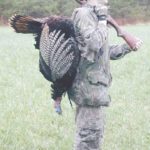
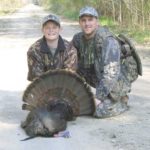
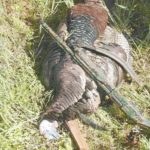
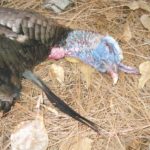
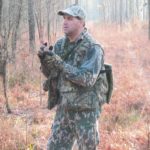


Be the first to comment